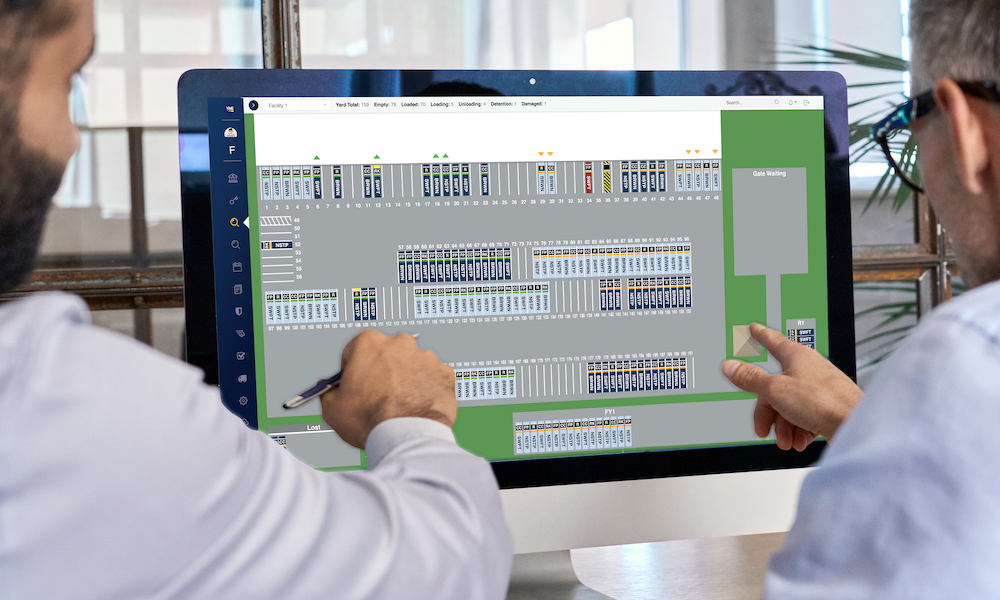RFID Technology In Yard Management
While radio frequency identification (RFID) technology is often considered for tracking and managing assets, it comes with significant drawbacks. High implementation costs, maintenance challenges, and accuracy issues can hinder its effectiveness in yard management. Many businesses in have faced these limitations and sought better alternatives for asset tracking.
Understanding RFID Meaning and Application in Yard Management
Radiofrequency identification (RFID) technology uses tags attached to assets, like trailers, to uniquely identify their location. There are two types of RFID tags: passive and active.
Types of RFID Tags:
Passive RFID Tags: These tags lack their own power source and rely on the reader's signal to activate. They are less expensive but have a shorter read range.
Active RFID Tags: These tags have a battery, allowing continuous signal broadcast and a wide range. However, they are more expensive.
Application in Yard Management:
Tag Placement: RFID tags, regardless of the type of tag, are placed on the nose of the trailer during the arrival process. Some trailers come with RFID chips permanently affixed, while others have tags applied upon arrival.
Tag Reading: Once the trailer enters the yard, it is positioned so the RFID tag points outward. Yard trucks equipped with RFID readers pass in front of the trailers to detect the tags. Fixed antennas in the yard are insufficient for this task.
Geocoding: Before tracking can occur, the yard must be geocoded. This involves mapping out each parking spot and dock door within the yard.
How It Works:
Reading the Tag: The yard truck reads the RFID tag.
GPS Integration: The truck's GPS location is used to determine where the trailer is parked.
Data Combination: The combination of tag data and GPS location data helps identify the trailer's position.
The concept behind this technology is to eliminate the need for manual yard checks by automating the process of locating trailers.
The Hidden Costs and Inefficiencies of RFID
High implementation costs are a significant drawback of radio frequency identification systems. These systems require extensive hardware, including tags, antennas, and readers. The financial investment for purchasing this hardware is substantial. Additionally, installation involves geocoding the entire yard, which is a time-consuming and expensive process.
Geocoding requires precise mapping of the yard to ensure that signals are accurately matched with specific locations, necessitating specialized labor and extended implementation timelines. The overall setup not only incurs high initial costs but also demands significant resources in terms of time and labor.
Maintenance challenges also plague RFID technology. RFID tags, although designed to be durable, can be easily damaged or lost in the rugged environment of a busy yard. This necessitates constant replacements to ensure continuous operation, adding to the ongoing costs.
Antennas and readers installed on yard trucks are prone to damage due to their exposure to harsh conditions and potential collisions. This leads to frequent repairs and replacements, which can disrupt operations and require additional expenditure. The maintenance of these systems, therefore, becomes a continuous and costly endeavor.
Inaccuracy issues are another critical concern with radio frequency identification systems. Despite their technological sophistication, RFID accuracy can be compromised by various factors such as physical obstructions, weather conditions, and the layout of the yard. These factors can interfere with the signals, leading to inaccurate readings.
These systems often fail to pinpoint the exact location of assets, resulting in errors that place trailers several spots away from their actual location. This inaccuracy undermines the primary purpose of implementing this technology, which is to provide precise and reliable tracking of assets. Moreover, the location data provided by RFID is not always real-time, further complicating tracking efforts. The inability to consistently deliver accurate, real-time location data can lead to operational inefficiencies and frustration among users.
Other Uses of RFID In Supply Chain Management
While RFID technology has drawbacks in yard management, it offers substantial benefits in other areas. In access control systems, RFID tags in ID cards allow secure and efficient access to buildings and restricted areas, managing large volumes of employees and visitors. In inventory management, RFID tags provide real-time tracking, enabling RFID readers to scan multiple items simultaneously, speeding up inventory processes and reducing errors. Ultra High Frequency (UHF) RFID systems, with their longer read range, are ideal for tracking large numbers of items in expansive environments like warehouses and distribution centers, enhancing overall supply chain management.

Better Alternatives to RFID Solutions in Yard Management
A highly effective alternative is process-driven software solutions. Modern yard management software can offer visibility and control without heavy reliance on hardware. These systems ensure accurate tracking and efficient yard operations. This approach is cost-effective, easy to implement, and provides immediate improvements in yard management.
Another promising solution is a hybrid approach that combines process-driven software with selective GPS hardware to offer optimal yard management. GPS sensors provide precise, real-time location data, reducing the need for extensive RFID hardware and cutting costs. This integration ensures accurate tracking and efficient operations without the high expenses of a full RFID setup. The flexible, scalable approach adapts to your yard's evolving needs, continuously improving efficiency and visibility.
Transitioning From RFID To Yard Management Solutions
At Yard Management Solutions, we have helped numerous customers transition from using radio frequency identification technology to our advanced yard management system, resulting in improved visibility and significant cost savings. Many of these customers initially invested in RFID systems with the expectation that it would provide precise tracking and management of their yard assets. However, they often found that the high implementation costs, maintenance challenges, and inaccuracy issues associated with this technology outweighed its benefits.
Our process-driven yard management software offers a seamless and efficient alternative. Unlike RFID systems that require extensive hardware, including tags, antennas, and readers, our software can ensure accurate tracking and efficient yard operations without the need for additional hardware investments. This shift not only reduces the upfront costs associated with hardware purchases and installations but also eliminates the ongoing expenses of maintaining and replacing damaged components.

Experience the Difference
Are you frustrated with the limitations of RFID or seeking a more efficient way to manage your yard operations? At Yard Management Solutions, we specialize in providing advanced, cost-effective alternatives that enhance visibility and streamline your processes. Our team of experts is ready to tailor a solution that meets your specific needs and helps you achieve operational excellence. Don’t settle for less—schedule a demo today and discover how our innovative system can transform your yard management.